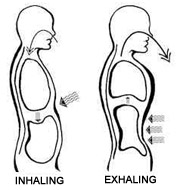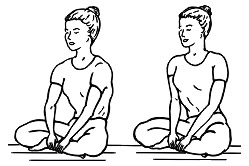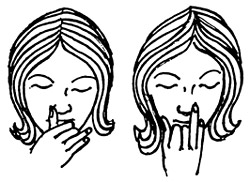On the path to self-realization breath is the bridge between the body and the mind. In Hinduism "breathing" is therefore the life force. It is that vital energy which sets every creation into motion. Breathing indeed plays an important role in Yogic meditation. Kundalini Yoga, which is even far more than just being a genre of the physical exercises gains that, desired diction with the support of the apt breathing techniques. Thus the different breathing techniques in yoga further supports in achieving that state of ideal spirituality. Some of the important types of breathing exercises that can be followed are given below:
Diaphragmatic breathing:
 The diaphragm is a huge muscle that rests horizontally across the base of the rib cage. The diaphragm is connected in the front, along the sides of the lower ribs, and also along the back.
When the diaphragm muscle contracts, it pulls the bottom of the lungs downward, causing them to fill, while the ribs flare outward to the sides. The chest and abdominal muscles are not used in diaphragmatic breathing.
On inhalation, the diaphragm muscle contracts, and on exhalation, this releases and the air goes out. With the practice of deep diaphragmatic breathing, the space just below the breastbone, at the upper abdomen pushes in slightly so as to exhale more completely.
The diaphragm is a huge muscle that rests horizontally across the base of the rib cage. The diaphragm is connected in the front, along the sides of the lower ribs, and also along the back.
When the diaphragm muscle contracts, it pulls the bottom of the lungs downward, causing them to fill, while the ribs flare outward to the sides. The chest and abdominal muscles are not used in diaphragmatic breathing.
On inhalation, the diaphragm muscle contracts, and on exhalation, this releases and the air goes out. With the practice of deep diaphragmatic breathing, the space just below the breastbone, at the upper abdomen pushes in slightly so as to exhale more completely.
In diaphragmatic breathing upper chest and lower abdomen remains motionless or still, use of these two can cause bad breath and other problems. So diaphragmatic breathing helps to attain this motionlessness in these two parts. This is a self-training program and nobody can teach the procedure.
The simple procedure is- one has to breath with the diaphragm allowing the ribs to slightly flare out to the sides, while the shoulders, upper chest and abdomen remain motionless. Then should breath smoothly without any disturbance in the steady flow and breath slowly within comfortable capacity with sufficient air and no straining. The breath should flow continuously without any pause between exhalation and inhalation and visa versa. When the practice is comfortable one should allow the exhalation to be twice as long as the inhalation.
The one biggest problem in learning diaphragmatic breathing is to know where is it located. Belly breathing, chest breathing, and shoulder breathing are simply not diaphragmatic breathing. One of the main problems with all forms of breath training, whether for meditation or clinical reasons, seems to be a misunderstanding of the location of the diaphragm.
Part from the process of the successful awakening of the Kundalini diaphragmatic breathing has also been acknowledged by the modern medicine. Modern medicine has finally recognized that the breath is intimately connected to the autonomous nervous system and the mind.
Agni breath or breath of fire:
Breath of Fire is a breathing exercise where one should inhale and exhale rapidly through the nose without pausing, and pump the navel point while using the abdomen as a bellows. This can be taught after long deep breathing or diaphragmatic breathing. This is also an important breathing technique of Kundalini Yoga.
Breath of Fire will entirely charge the nervous system, causing the glands to secrete and purify the blood. When it is done with certain postures and movements, which are meant to put contracting or expanding pressure in nerve plexuses and glandular centers, those areas are made to fire and therefore become completely charged.
As an area becomes charged, the sexual fluids are released into the bloodstream and flow to those charged areas, so that gradually those areas will maintain that charge and "pranic" pressure builds throughout the body converting Bindu to Ojas, which fills and permeates the entire body and mind.
Over a period of few weeks of sets and kriyas combining posture, movement, breath, sound and locks, the entire body will begin to feel magnetically electric, as the field becomes balanced with an inward dynamo-like force. As this charge builds and polarizes, the mind becomes still, clear and bright, and a radiance is felt in and around the body and head.
Solar and lunar breaths:
The breath and the underlying energy, or Prana, usually flow predominantly on one side or other, the left or the right. Breath mainly in the left nostril is described as cool, and sometimes referred to as feminine. It is the lunar one, and is called Ida. Breath flowing predominantly in the right nostril is described as hot, and sometimes referred to as masculine. This breath flow on the right is the solar, and is called Pingala.
Spinal breath:
 This is a simple practice that can be done during meditation time or as part of the preparation for Yoga Nidra. One can do this after having done any of the vigorous breathing practices or just before meditation itself. This practice can also be done for relaxation lying on back in shavasana. In this practice breathing does exhalation from the top of the head to the perineum at the base of the spine and inhalation from the perineum at the base of the spine to the top of the head. One may simply experience the breath, or may be aware of a thin, milky white stream flowing in a straight line, up and down. This practice is very subtle when experienced at its depth, and can turn into a profoundly deep part of meditation practice. Sometimes this spinal breath practices are considered to be part of, one and the same with Kundalini Yoga or Hatha Yoga.
This is a simple practice that can be done during meditation time or as part of the preparation for Yoga Nidra. One can do this after having done any of the vigorous breathing practices or just before meditation itself. This practice can also be done for relaxation lying on back in shavasana. In this practice breathing does exhalation from the top of the head to the perineum at the base of the spine and inhalation from the perineum at the base of the spine to the top of the head. One may simply experience the breath, or may be aware of a thin, milky white stream flowing in a straight line, up and down. This practice is very subtle when experienced at its depth, and can turn into a profoundly deep part of meditation practice. Sometimes this spinal breath practices are considered to be part of, one and the same with Kundalini Yoga or Hatha Yoga.
Walking breath:
This is a wonderful practice that can be done in daily life, it integrates body, breath and mind. One can count internally with exhalation and inhalation while walking. By virtue of this internal breathing breath becomes even, body and breath synchronizes and automatically mind synchronizes with the body and breath.
To find the right and comfortable pace and in association with the speed of walking is important in this type. This practice can easily be done when you are walking even 1-2 minutes from one place to another.
Alternate nostril breathing:
 When energy is not balanced it can be seen in nostrils. Most of the time one or the other nostril is more dominant, allowing air to move more freely. However when they are flowing evenly, the mind really likes to be quiet and meditate.
Alternate Nostril breathing is a method where one consciously works with that energy by regulating the physical breath in one or the other nostril. This in turn affects the energy and mind. It brings balance, and allows the energy to flow in the center, rather than on the left or right side.
When energy is not balanced it can be seen in nostrils. Most of the time one or the other nostril is more dominant, allowing air to move more freely. However when they are flowing evenly, the mind really likes to be quiet and meditate.
Alternate Nostril breathing is a method where one consciously works with that energy by regulating the physical breath in one or the other nostril. This in turn affects the energy and mind. It brings balance, and allows the energy to flow in the center, rather than on the left or right side.
To control the flow of breath, one usually begins by using their fingers to block off one nostril so as to allow the other to flow and visa versa. This cycle will be repeated several times. One easy method of this practice is to exhale and inhale from one nostril five times and then from the other, which is called a `round`.
This physical act affects on the autonomic nervous system, and allows one to become "centered. Both nostrils flow smoothly and mind becomes relaxed.




















